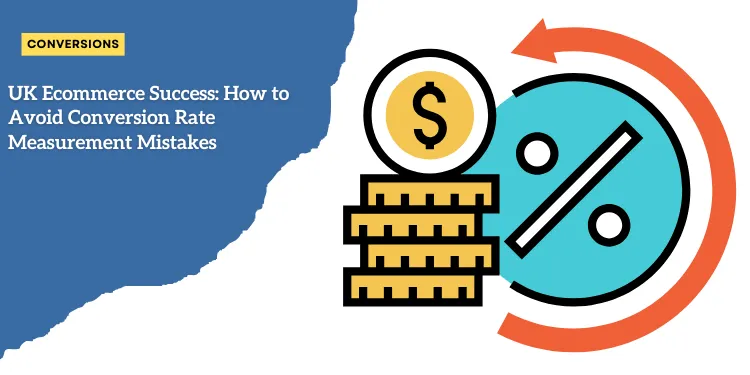UK Ecommerce Success: How to Avoid Conversion Rate Measurement Mistakes

Anúncios
Definition of Ecommerce Conversion Rate and Why It Matters
An ecommerce conversion rate is the percentage of visitors who take a desired action on your website, such as making a purchase.
This metric is crucial because it directly reflects the effectiveness of your online store in converting visitors into customers.
Anúncios
It essentially measures the success of your marketing and user experience strategies. Understanding this rate helps businesses identify areas for improvement, optimize their sales funnel, and ultimately drive more revenue.
Key Differences Between Conversion Metrics in Ecommerce
Not all conversion metrics are created equal. In ecommerce, you need to differentiate between overall conversion rates and ecommerce-specific conversion rates.
The overall conversion rate encompasses all conversion actions taken by visitors, including signing up for newsletters, adding items to the cart, or using a contact form. On the other hand, the ecommerce conversion rate specifically measures completed purchases.
Anúncios
This distinction is important because conflating the two can lead to misinterpretations of your site’s performance.
For instance, high newsletter sign-ups may inflate your overall conversion rate, while your ecommerce conversion rate (actual sales) might remain unaffected.
Why Accurate Measurement is Crucial for UK Online Retailers
For UK online retailers, precise measurement of ecommerce conversion rates is paramount.
Misreporting metrics can lead to flawed strategic decisions, wasted marketing budget, and ultimately, lost sales.
The ecommerce landscape is competitive, and having a clear, accurate understanding of your conversion rates is essential for making informed decisions.
Additionally, with various EU and UK data protection regulations, maintaining precise and compliant data collection practices not only ensures you stay within legal boundaries but also enhances trust with your customer base.
Moving forward, it’s imperative to further dive into specific debates and subtleties in measurement, like understanding why sessions are the industry standard over users for calculating conversion rates and the implications for high-ticket item retailers.
The Sessions vs Users Debate
When diving into the world of ecommerce metrics, it’s crucial to understand the debate between sessions and users.
This chapter will help you grasp why sessions are the standard for calculating conversion rates in the industry and why switching to user-based metrics can inflate your data. We’ll also cover special considerations for high-ticket item stores.
Why Sessions Are the Industry Standard
Sessions, also known as visits, are the preferred metric for calculating ecommerce conversion rates because they provide a more accurate representation of customer behaviors over time.
When someone visits your website, analytics tools count this as a “session” and identify the person or their device as a “user.” For instance, if you visit a website on Sunday and return on Monday, you’re seen as one user with two sessions.
Ecommerce conversion rate is calculated using the number of orders and the number of sessions within a period, not the number of users.
This method provides clearer insights into the customer journey and the effectiveness of your marketing strategies, ensuring you pinpoint the precise moments that lead to a conversion.
Inflated Metrics Using Users
Choosing to use users instead of sessions can significantly inflate your conversion metrics and lead to misleading conclusions.
This inflation happens because users may return to your site multiple times before making a purchase.
Counting users rather than sessions can give the illusion of a higher conversion rate since it ignores the multiple touchpoints that often lead to a final sale.
For example, one user who visits your site five times before making a purchase results in a conversion rate calculation based on five sessions, giving you a more accurate picture of the customer journey.
When focusing on users alone, you may only see the end result and not the efforts that contributed to it, making your data less actionable.
Special Considerations for High-Ticket Item Stores
For stores selling high-priced items, the debate between sessions and users becomes even more pertinent.
High-ticket items typically require more research, comparison, and careful consideration, meaning customers are likely to visit your site multiple times before committing to a purchase.
Using sessions in these scenarios helps you track each engagement and develop insights into how customers interact with your content over time.
This detailed view can inform decisions like when to invest in retargeting campaigns or which touchpoints are most influential in driving conversions.
While some marketers advocate for user-based metrics in these contexts, sticking with session-based metrics aligns with industry norms and offers a more comprehensive understanding of your customers.
Recognizing these nuances between sessions and users is pivotal for accurately measuring ecommerce performance.
It ensures that your conversion rate calculations are reliable and actionable, guiding your decisions to enhance overall business success.
Next, we’ll delve deeper into overall conversion rates versus ecommerce conversion rates to further clarify your understanding.
Overall Conversion Rate vs Ecommerce Conversion Rate
Understanding What Actions Contribute to Overall Conversion Rate
When dissecting the performance of an ecommerce website, it’s crucial to understand the difference between the overall conversion rate and the ecommerce conversion rate.
The overall conversion rate encapsulates any meaningful action a visitor might take during their visit.
This isn’t limited to purchase transactions but includes a range of actions such as:
- 📧 Newsletter subscriptions
- 📅 Presale signups
- 🛒 Adding items to a wishlist or cart
- 📚 Downloading a resource or guide
By including these various actions, the overall conversion rate tends to present a broader view of user engagement.
Why Ecommerce Conversion Rates Are Typically Lower Than Overall Rates
Now, if you narrow the focus specifically to ecommerce conversion rates, we look solely at the percentage of visitors who complete an actual purchase.
Here, the bar is set higher. Unlike general conversions that can involve easier, less committed actions, a purchase demands more from the user—financial commitment, decision-making, and trust.
Due to this higher requirement of a complete transaction, the ecommerce conversion rate typically appears lower than the overall conversion rate, reflecting the number of visitors who made a purchase out of the total sessions.
How to Properly Differentiate Between Different Types of Conversions
By clearly distinguishing between overall conversion rates and ecommerce conversion rates, you prevent confusion and misinterpretation:
| Metric 📊 | Description | Importance |
|---|---|---|
| 📈 Overall Conversion Rate | Measures the percentage of visitors completing any desired action on the site, such as signups or downloads. | Helps assess the overall engagement and effectiveness of the site in converting visitors into leads. |
| 💵 Ecommerce Conversion Rate | Focuses on the percentage of visitors who make a purchase, specifically tracking revenue-generating actions. | Critical for understanding how effectively your store turns visitors into paying customers. |
| 🎯 Click-Through Rate (CTR) | Measures the percentage of users who clicked on a recommended product or ad. | Indicates how attractive and relevant the recommendations or ads are to users. |
| 🛒 Average Order Value (AOV) | Tracks the average value of orders placed on your site over a given period. | Helps assess if your upselling or cross-selling strategies are effective. |
| 💰 Revenue Per Visit (RPV) | Calculates the revenue generated per user visit to your site. | Gives a comprehensive view of the overall financial impact of site visits. |
| 🔄 Bounce Rate | Indicates the percentage of visitors who leave the site after viewing only one page. | A lower bounce rate typically means visitors are engaging more with your site and its content. |
Each type of conversion provides valuable insights.
Accurate categorization ensures that marketing strategies and performance evaluations are based on clear, reliable data, ultimately contributing to a more targeted and effective business growth approach.
Recognizing these differences paves the way for implementing best practices in accurate conversion tracking and understanding the true health of your online store’s performance.
Common Measurement Pitfalls
Success in ecommerce depends heavily on accurate measurement.
Many online retailers, including those in the UK, face common pitfalls that skew their understanding of key metrics.
Let’s delve into these challenges and how to overcome them.
Mixing Different Conversion Metrics in Reports
One major pitfall is combining different types of conversion metrics in the same report.
When metrics such as add-to-cart rates, signups, and actual purchases are lumped together, the result can be a distorted view of performance.
This mixing can inflate conversion data, making it appear that the site is performing better than it actually is.
For accurate insights, ensure you separate metrics based on specific conversion goals.
Overvaluing Vanity Metrics Like Newsletter Signups
Another common issue is placing too much value on vanity metrics like newsletter signups.
While these actions have their importance, they do not directly translate into sales.
Reporting that emphasizes these over actual purchases can lead to misguided strategies.
Focus on metrics that align with the core business objectives, such as completed orders, to get a realistic picture of performance.
How to Avoid Double-Counting Conversions Across Multiple Sessions
Double-counting conversions is a significant concern that can lead to overestimating performance.
For example, if a user returns to complete a purchase over multiple sessions, counting each session as a separate conversion inflates numbers artificially.
To avoid this, configure your analytics tools to track and attribute conversions correctly. Consistent and clear tracking ensures accurate data collection and prevents this common pitfall.
Understanding these common pitfalls and implementing measures to avoid them is crucial for any UK ecommerce business.
This understanding leads to more precise insights and better decision-making for growth.
To maintain accuracy and clarity, always separate conversion metrics, focus on meaningful data, and ensure your tracking setup is robust.
This foundational knowledge sets the stage for establishing consistent reporting standards.
Best Practices for Accurate Conversion Tracking
Setting Up Proper Analytics Tracking for UK Ecommerce Sites
For UK ecommerce sites, setting up accurate analytics tracking is absolutely essential to gauge performance correctly.
Start by integrating a robust analytics tool like Google Analytics or Adobe Analytics.
Ensure that your tracking code is properly implemented across all pages of your site. This helps in capturing every user interaction accurately.
Then, configure your goals within the analytics tool to align with key business objectives.
Whether it’s the completion of a purchase, adding items to a cart, or newsletter sign-ups, setting specific goals will provide clear insights into how well your site is performing.
Choosing the Right Metrics for Your Business Model
Choosing the right metrics is crucial for understanding your ecommerce store’s health.
Metrics should align with your business model and key performance indicators (KPIs). For retail-focused sites, prioritize metrics like ecommerce conversion rates, average order value, and cart abandonment rates.
For content-driven ecommerce stores, metrics such as time on site, pages per session, and social shares might also be relevant.
Always distinguish between overall conversion rates and ecommerce conversion rates to avoid misinterpreting your store’s performance.
Establishing Consistent Reporting Standards
Consistency is key when it comes to reporting standards in ecommerce. Establish a regular reporting cadence—be it daily, weekly, or monthly—so that your team can track performance trends over time.
Ensure that all reports use the same metrics and definitions to maintain comparability across periods.
Avoid mixing different conversion metrics in a single report, as this can lead to confusion.
Stick to session-based metrics, as these are the industry standard, and avoid over-relying on vanity metrics like newsletter signups unless they are a core part of your conversion strategy.
Always review your metrics for accuracy to ensure comprehensive and precise data collection.
Establishing these practices will help your ecommerce store maintain clear, actionable insights while minimizing errors and inconsistencies.
As you streamline your analytics, remember that every bit of accurate data brings you closer to understanding your customers better and enhancing their shopping experience.






